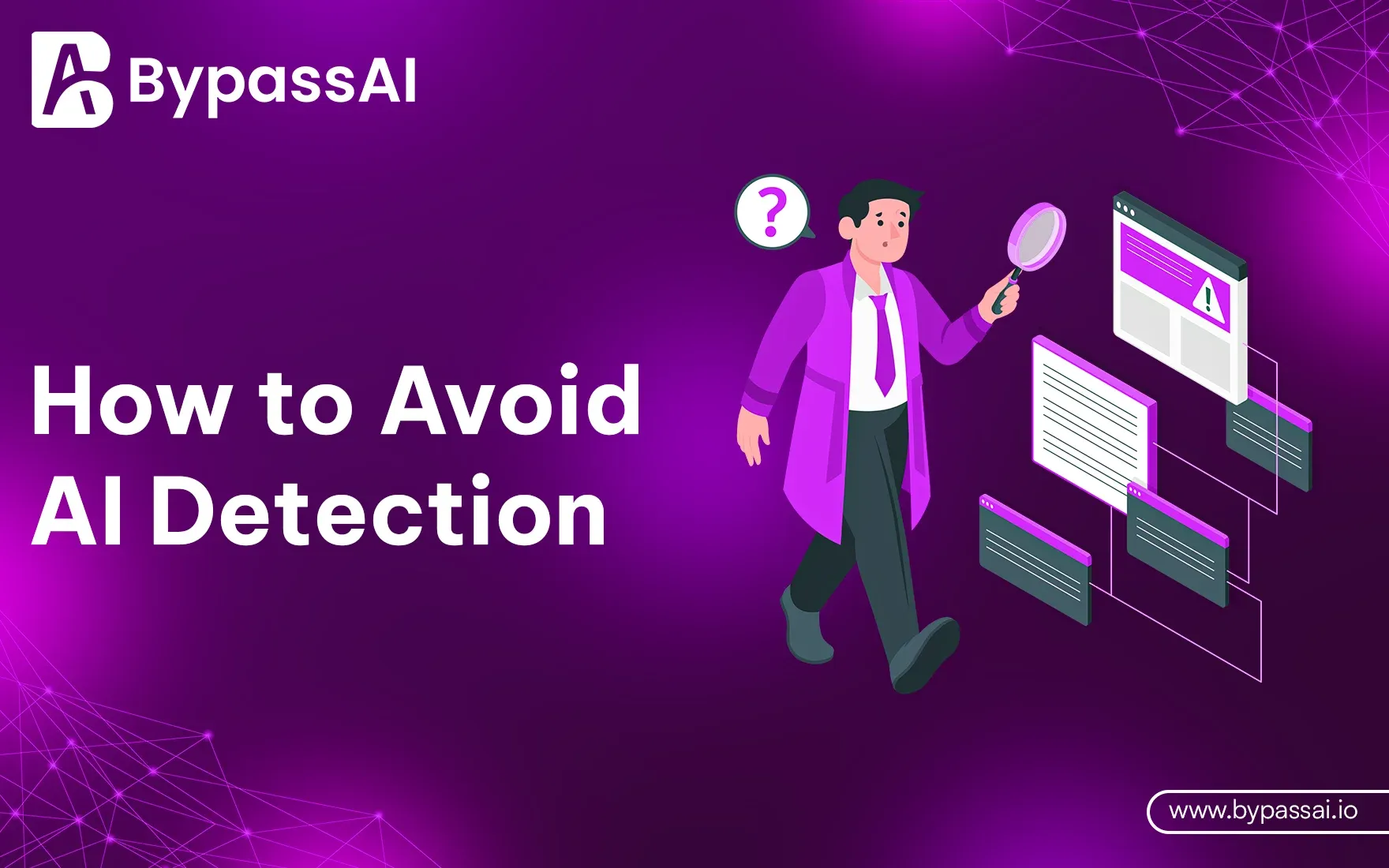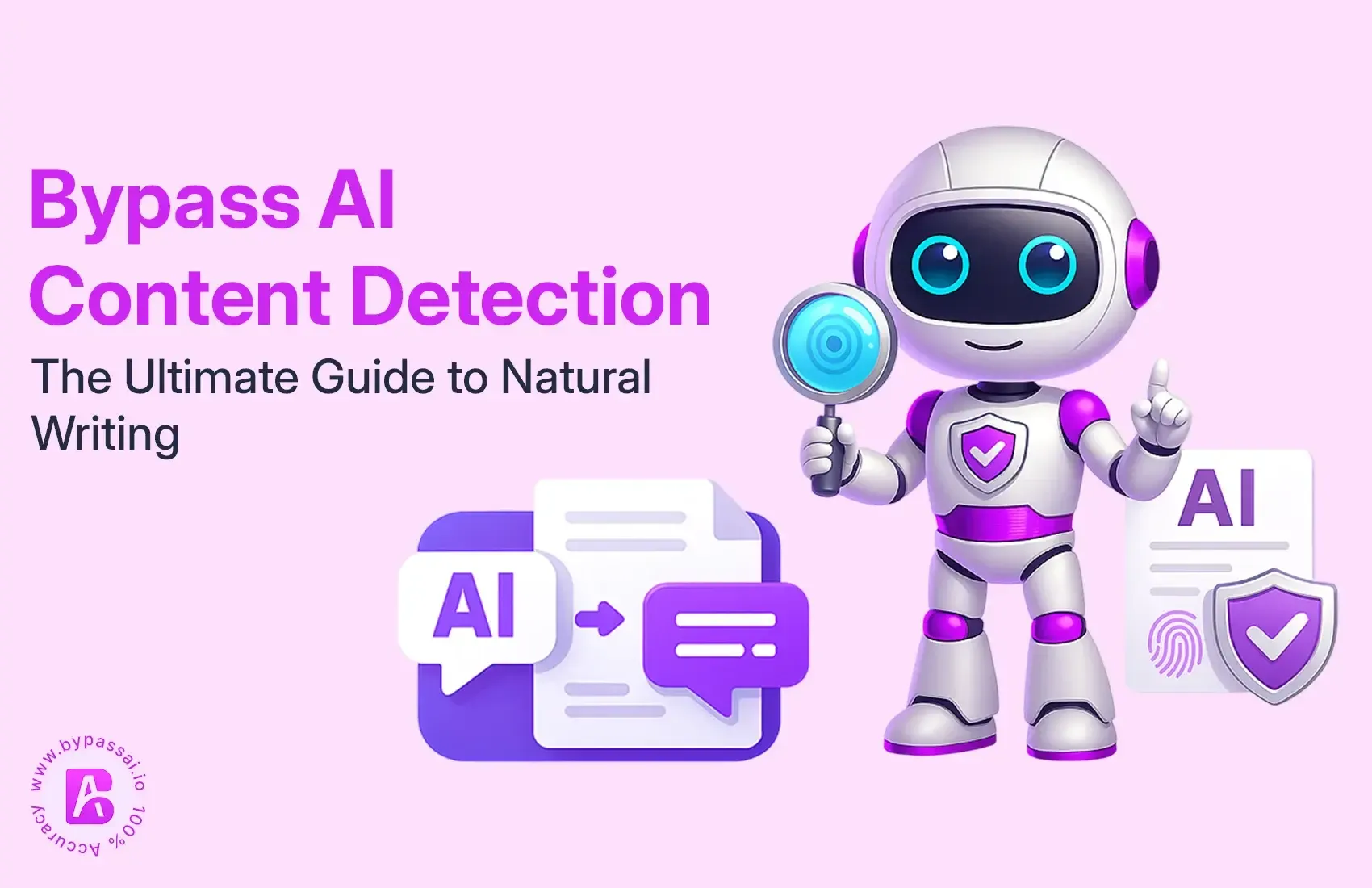Sign In
Welcome to Bypass AI! Sign in to continue your exploration of our platform with all its exciting features.
Forgot Password?
Don’t have an account ? Sign up
Sign Up
Embrace the Future with Bypass AI! Sign up now and let's rewrite the possibilities together.
You have an account ? Sign In
Enter OTP
We’ll send you an OTP on your registered email address
Back to Login
Forgot Password
We'll Send You An Email To Reset Your Password.
Back to Login
Enter OTP
We'll send you an email to reset your password.
Back to Login
Confirm Password
Please enter your new password.
TABLE OF CONTENTS
Quick Summary
What is AI detection?
What are AI detection tools?
Can AI detectors identify AI-generated content?
Avoiding AI detection with these techniques
Can Google detect AI content?
When should you avoid using AI content?
Key takeaways
Conclusion
FAQs
There's a lot of buzz around ChatGPT. It's got folks asking, "how to avoid ai detection?" Schools, colleges, they've tried to stop students from using it for their papers. Yet, there are methods to stop copying and keep AI-made content under the radar.
SEO firms rely on AI identification systems like Bypass AI Detector. They use this to make sure their content doesn't seem like it's AI-written. If they don't do this, they could be penalized. All their work could go to waste.
This is where the challenge comes in. If you use an AI content generator as a replacement for a “real human writer” without editing or upgrading, you run the risk of being found
AI should be used as a tool, not a replacement for the human author.
You need to use AI-generated content as a starting point and then take the time to fine-tune it so that it reads naturally.
This way you can have the best of both worlds: unique content in a fraction of the time that looks like it was written by a human.
In this post, we’ll look at five best practices to avoid AI detection as a writer. Whether you’re writing a blog post or an essay, these tips will help keep your content safe and found.
Quick Summary
Avoid AI detection needs tactics such as changing words and phrases, adding personal stories, and switching around synonyms and look-alike characters. Tools like BypassAI IO and Grammarly spot AI-crafted material by looking at trends and methods. While AI spotting gear is refined, they can be wrong about human-penned stuff. To make the work seem made by a person, careful adjustment, shifting the words, and not repeating phrases are needed. Mixing AI's work with human input can result in top-notch content that won't be spotted.
What is AI detection?
AI detection involves telling the difference between text written by a computer program and text penned by a human. It's about examining how sentences are arranged, repetition of words, and certain patterns in writing that hint the work of an AI content generator.
Spotting AI in content is more important. This holds true for digital publishers. It's important for SEO and content marketing. It's also vital in image and video creation.
Recognizing AI in writing matters, as content made by AI can affect how people view the quality and realness of any piece. People usually think human-created text is worth more than text made by AI.
This may be because of the truth that a human writer will spend extra time and effort writing. A common fallacy is to equate greater time with better price.
Detecting the use of AI writers can also be useful in different eventualities, including whilst you're outsourcing content material writing or growing authentic instructional studies.
However, AI detection isn't always necessary in case you're creating articles to rank better in serps. Google has time and again announced that its awareness isn't always on how content is created but on the fee it delivers.
What are AI detection tools?
AI detectors are gadgets built to pinpoint if a write-up is fully or partly created by tools like ChatGPT, powered by AI. They employ machine learning and natural language handling to scrutinize language trends, sentence organizations and other traits to tell if humans wrote the content or if AI whipped it up.
1. BypassAI IO
BypassAI IO acts as a tool that spots AI-written text, employing machine learning for text examination. It gives a score that marks the chances of AI creating the text. BypassAI IO aims to assist those who create content, publishers, and teachers in spotting content made by AI.
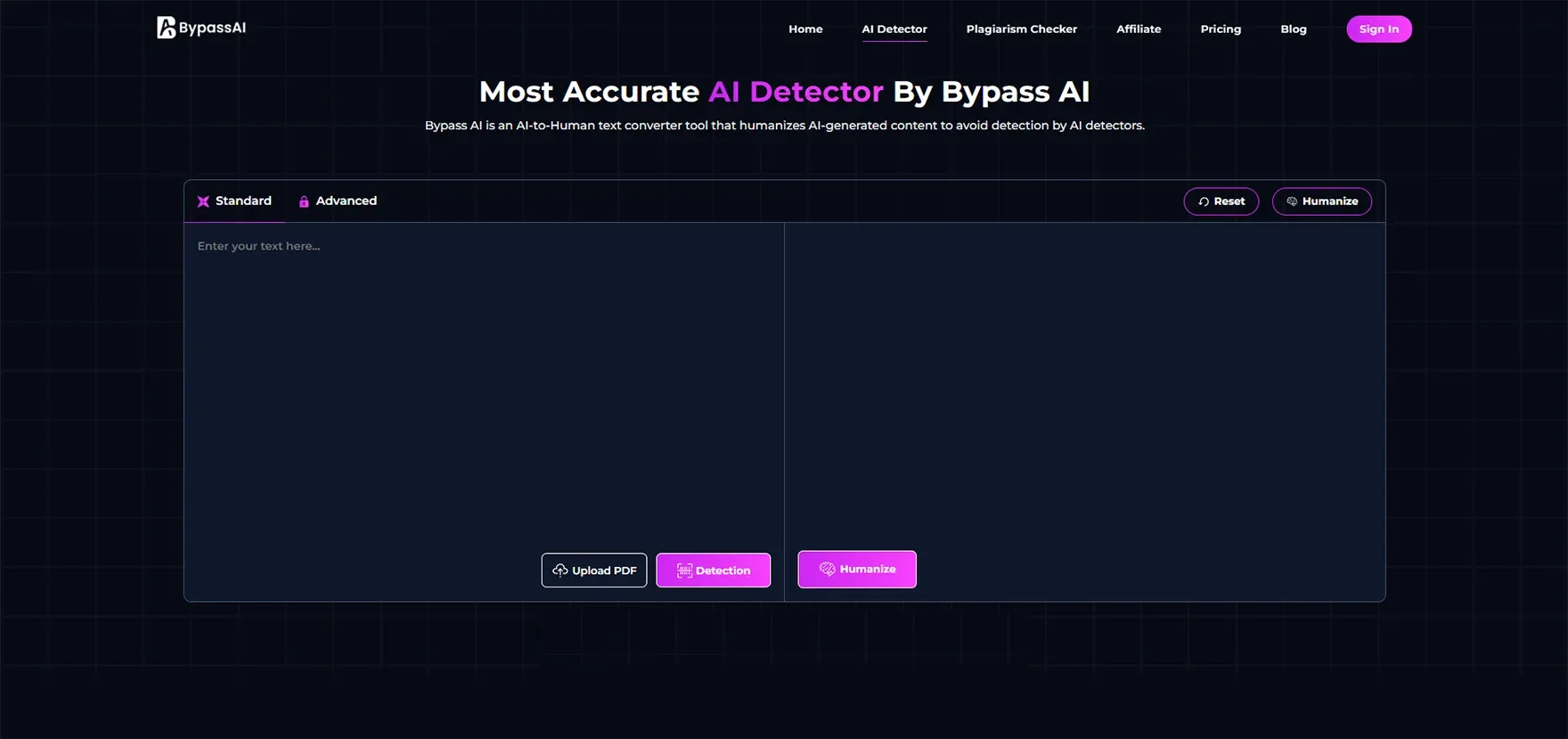
2. Surfer AI detector
Surfer's AI program learns from both computer-made and human-touched writings. It spots familiar language patterns, word choices, and sentence formats that hint at content made by AI.
The AI detector from Surfer gives you the chance to make your AI-created content seem closer to human-generated writing, without altering the original message of your text. This reworked material could help you bypass AI content detectors due to its human-like writing style.
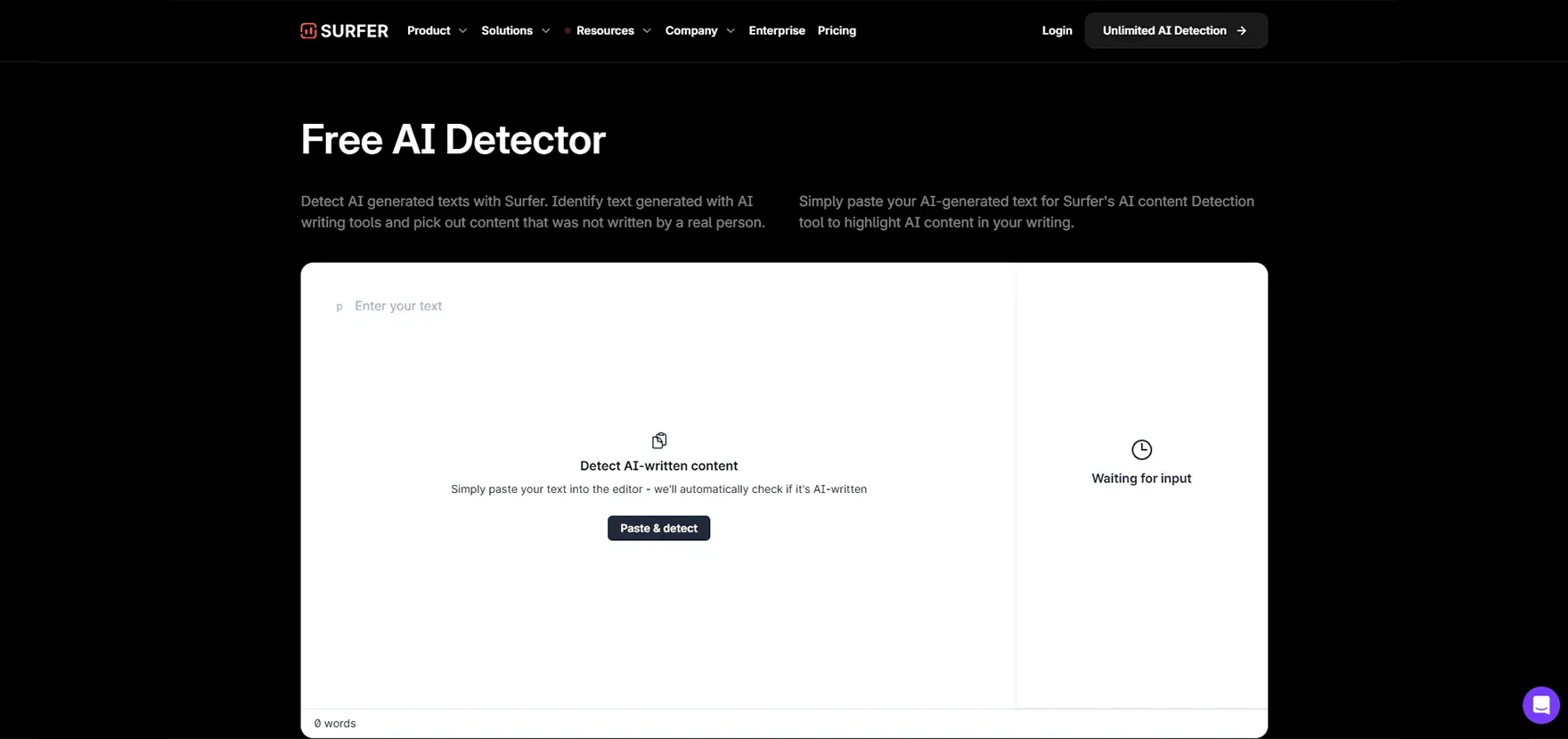
3. Grammarly
Grammar is a popular writing aid tool that can also be used for AI-generated searches. While its primary function is to provide grammar, spelling and style suggestions, Grammarly also has the ability to analyze text and flag potential AI-induced effects
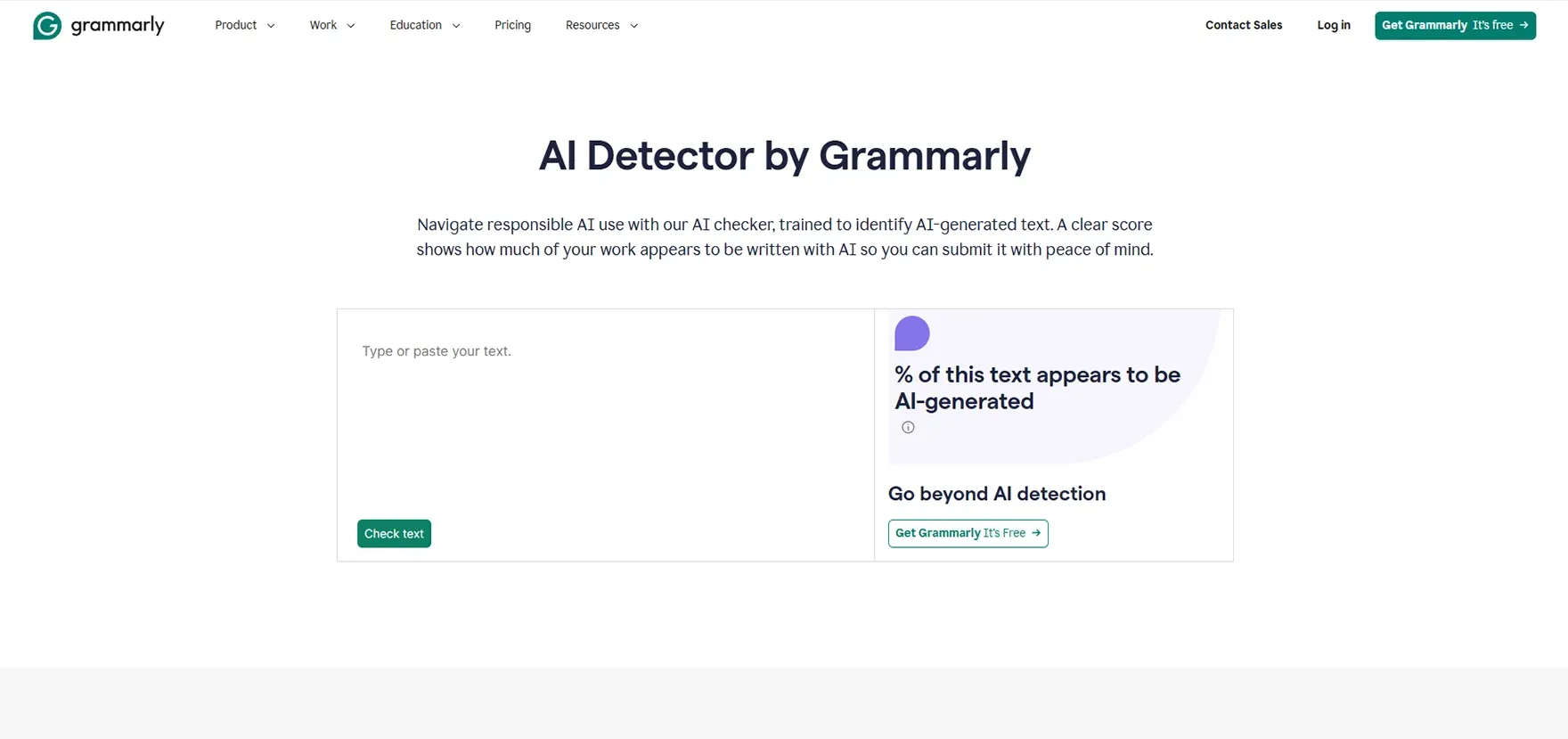
4. Originality AI
The Chrome Extension, Originality.AI, was crafted by professionals in content marketing. It identifies various GPT renderings with an impressive 94% precision. It examines text, rating it between 0-100. A higher rating suggests a greater probability of AI authorship. Additionally, this tool can check for copied work – a plus for teachers. It works best when evaluating over 50 words.
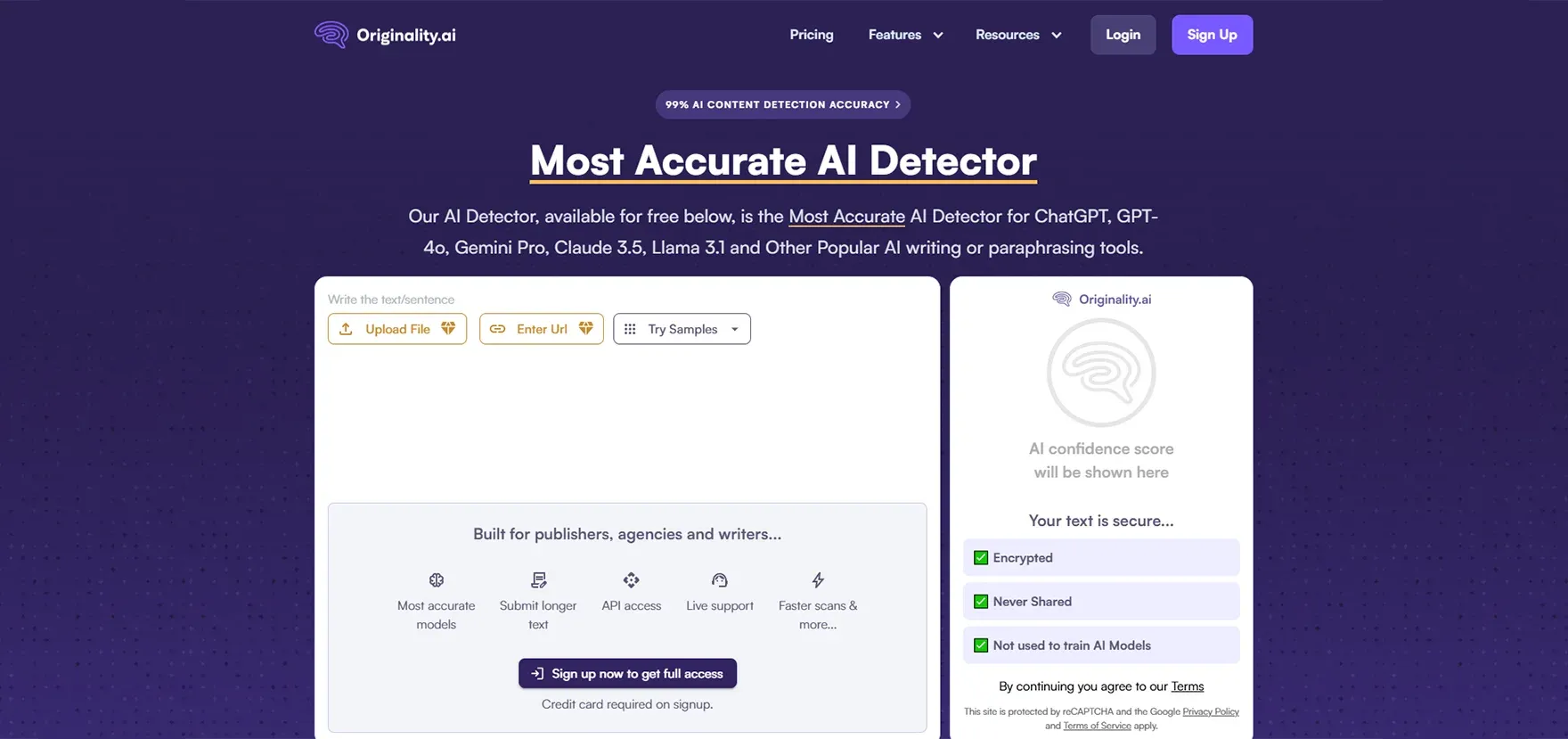
5. Turnitin
Turnitin unveiled an AI tool for detecting AI-generated writings, a resource mainly designed for establishments. Availing the utility demands discussion with a sales agent, hence not a simple process. Its cost is kept under wraps, and there's no provision for buying personal licenses. This innovative product syncs with other programs of Turnitin like Turnitin Originality. In practical terms, the software dissects a piece of writing into chunks and scores each range from 0 (written by a human) to 1 (created by AI).
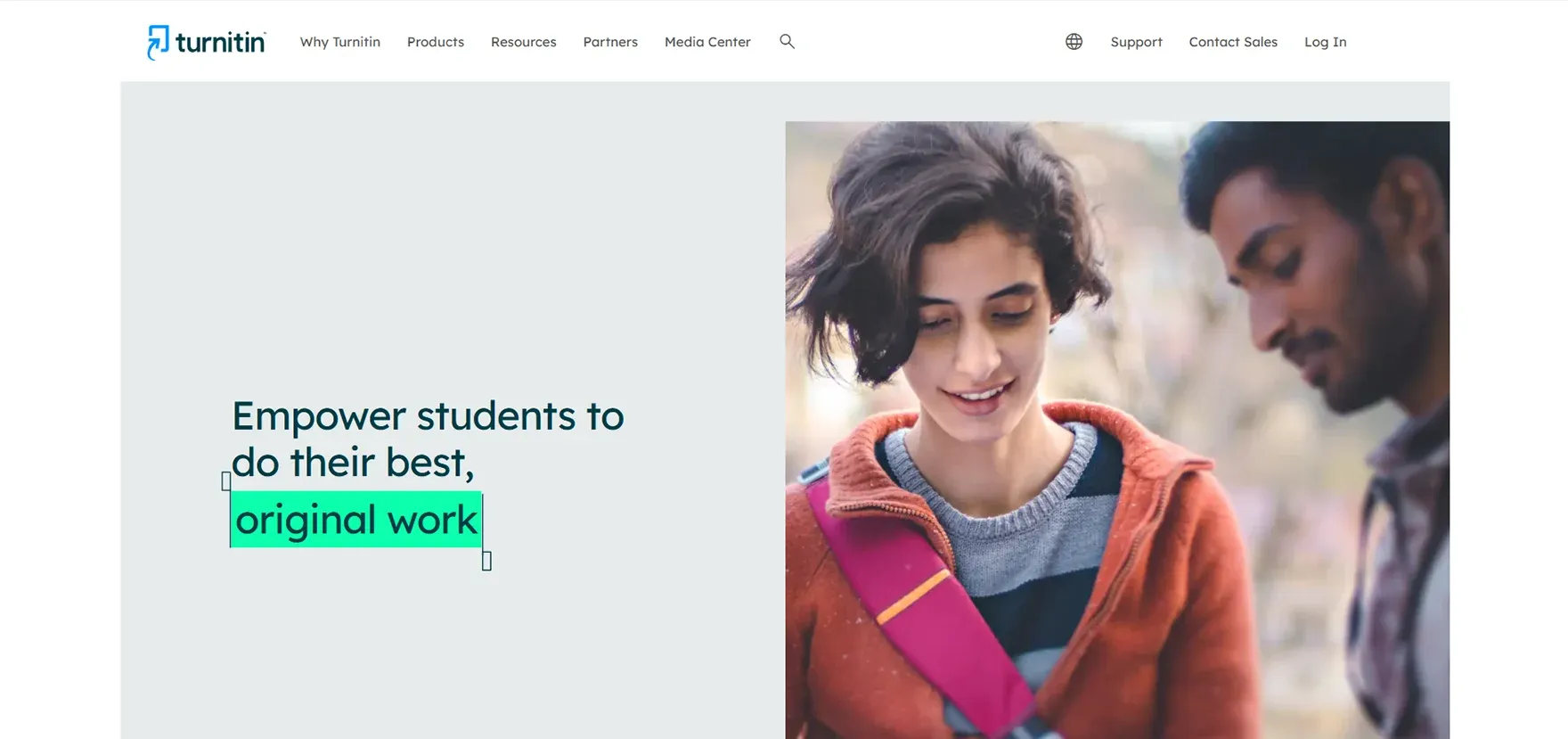
Also read this article : How do AI content detectors work?
Can AI detectors identify AI-generated content?
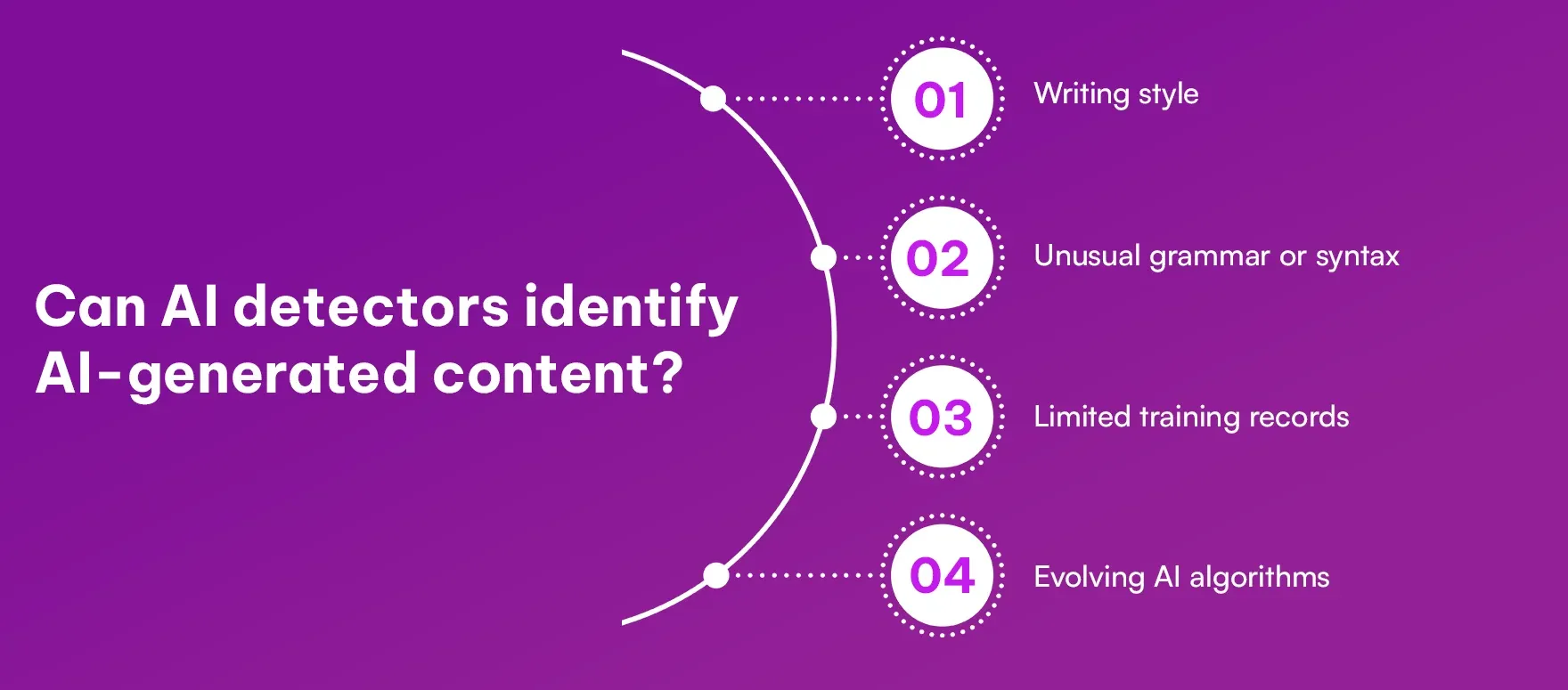
AI content checks don't always hit the mark. They can sometimes mistake real for fake. Because AI tools look at how things are written, they can get mixed up. They might mark pieces written by people as AI if they have a certain style.
While excellent, these gadgets aren't flawless. It's common for them to mislabel content penned by humans as AI-created, influenced by specific aspects.
Writing style: You may inadvertently use language styles or phrases similar to the ones generated by means of AI models. Repetitive phrases or ideas: You is probably the usage of similar terms multiple instances to your writing. This is one of the maximum commonplace motives for fake AI content detection.
Unusual grammar or syntax: If your writing makes use of unconventional grammar or sentence systems, AI detection tools might misinterpret this as a sign of AI-generated content.
Limited training records: AI detection gear depend on training records to discover ways to distinguish among human and AI-generated content material. If the schooling data of the AI detector is constrained or biased, it can affect the device's accuracy and result in false readings.
Evolving AI algorithms: As AI writing models come to be greater advanced and able to mimicking human-like language patterns, it is turning into extra difficult for detection gear to differentiate between human and AI-generated content appropriately.
AI detection gear are continuously having to improve and adapt to new trends in AI-generated content material. However, false detections of human-written content material as AI-generated may nonetheless arise because of the factors above.
Avoiding AI detection with these techniques
Avoiding AI detection involves understanding how AI systems detect and flag AI-generated content. Here are some techniques and strategies that people might use to make AI-generated text appear more human-like:

1. Avoid repetition
The next tip is to make sure that you don’t use any common words or settings when talking to ChatGPT.
Artificial intelligence dialogue can often be recognized by its dependence on models and concepts that use formal language. This robot-like conversation can make AI detection easier, so keep your conversation as relevant as possible to avoid detection.
Try to maximize your vocabulary and sentence structures and avoid monotonous or conventional language. The following are examples of repetitive or written forms and avoidance techniques.
- Example: Instead of repeating "great" multiple times, use synonyms like "excellent," "wonderful," and "fantastic."
2. Using Unicode Characters
You can cleverly slip past AI recognition tools using Unicode characters. Just substitute some characters or symbols with their Unicode versions. This lets you alter how words look without messing with what they mean.
- Example: Instead of writing "hello," use "hεllo" with a Greek letter epsilon.
3. Adding Punctuation and Symbols
Icons and logos, added correctly, assist AI in avoiding object identification. One way to do this is by splashing unusual characters into your words. Swap an 'o' for a zero or use '@' instead of 'a'. So, "free" turns into "fr33" or "fr@3" now. Another trick? Scatter punctuation! Add it within words or between them. Toss in extra ! or ? for good measure.
However, it’s important to maintain readability and not overdo it, as overuse can make the content seem spammy or unreliable.
4. Using Homoglyphs
Homoglyphs, symbols alike in appearance, can potentially confuse AI detection tools. Substituting some letters or signs may increase difficulty for AI to clearly spot prohibited or flagged items.
- Example: Replace "A" with "А" (Cyrillic) or "B" with "В" (Cyrillic).
5. Share personal anecdotes and perspectives
Using real-life examples, stories, or analogies can help readers understand your message and make your content more compelling.
Adding personal anecdotes and real-life experiences to your story can add a special dimension that AI can emulate.
It’s important for brands and content creators to build trust and confidence in their audience.
Example: "Last summer I went to a small town in Italy. The experience was surreal—something I will cherish forever."
- Example: "Last summer, I visited a small town in Italy. The experience was surreal—something I’ll cherish forever."
6. Altering Word and Sentence Structure
Word swapping and sentence structure can help AI avoid filtering. You can update your style by introducing synonyms or rearranging parts of a sentence. For example, instead of using "important," you can choose appropriate alternatives such as "important" or "important."
- Example: Instead of "She loves reading books," try "Books are what she loves to read."
Are you ready to elevate your writing and avoid AI detection? Use our Bypass AI detection today and experience the difference in your content's quality and authenticity.
7. Using Synonyms and Antonyms
A way to sneak past AI content trackers is to swap out similar or opposite words. This method helps you avoid detection but still delivers the same story.
- Example: "He was happy" can be changed to "He was elated" or "He wasn't sad."
8. Use human moderators
Reviewing articles generated by AI tools can help human editors identify areas for improvement and ensure content is easily understood and appealing to human readers.
When reviewing AI-generated articles, instruct your editors to look for common language or spelling, unnatural words, and clear signs that the articles were generated by AI tools.
- Example: A human moderator can adjust phrases like "AI writing is very fast" to "Writing with AI is incredibly speedy."
9. Rearranging Sentence Syntax
Rewording is an effective way to avoid AI content detectors. You can move away from search patterns based on specific grammatical structures or word combinations by changing the structure of words, phrases, or words in a sentence, such as rearranging word order to say "my eyes". take ice cream" instead of "I like ice cream." cream." ." These variables prevent AI from recognizing and flagging potential problems.
- Example: Instead of "The cat sat on the mat," use "On the mat sat the cat."
10. Paraphrase Your Content
The fourth step to avoid detecting AI when using ChatGPT is to use a tool like QuillBot for continuous analysis and basic understanding QuillBot is an artificial intelligence based tool that can be consumed role for additional presentation or reworked information
QuillBot can help make AI-created objects look more natural and less robotic. By rewriting information, you can reduce the chances of it being detected as plagiarism.
- Example: "The project was a huge success" can be paraphrased to "The project achieved remarkable success."
11. Check it yourself
To prevent ChatGPT from being identified by AI detection, count on trusted AI detection tools such as Originality.ai. This high-tech system, based on complex algorithms, adeptly spots AI-created content and copied material. Employing this tool guarantees that the produced text won't be mistaken for AI-sourced content.
- Example: Before publishing, read your content aloud to catch any unnatural phrasing.
12.Changing Word Forms
Use different forms of words (nouns, verbs, adjectives) to add variety.
- Example: "The solution was effective" can be altered to "The effectiveness of the solution was notable."
Can Google detect AI content?
For the most part certainly. It's got access to heaps of info and crafts its own AI resources. Strange though, that this AI can't perceive content.
But the critical question is, does it really make a difference? People often think that AI-created content is deemed unfavorable by Google, thus, it won't be effective. Correct? However, as I initially asserted, Google doesn't fret over who penned the material, whether human or AI. What truly matters to Google is whether users find value in the content or not.
When should you avoid using AI content?
Steer clear of AI-created works when writing for fields like Your Money Your Life (YMYL) or when showing expertise from your professional history is a must.
E-E-A-T is short for experience, expertise, authority, and trustworthiness. These are guidelines. Google uses them to judge whether content is legit and of good quality before it sends it out to its users.
Healthcare and finance disciplines are often considered YMYL (Your Money or Your Life) niches and need to be blended with human care and AI elements.
Here are a couple of points to avoid relying on AI content.
- Complexity and personalization
Health and money matters are tricky to handle. They usually need guidance built around personal needs and how much risk one can handle. AI may find it tough to juggle all these factors and give custom tips.
- Liability and responsibility
In cases in which AI-generated advice results in terrible outcomes, assigning legal responsibility and accountability may be hard.
Legally, it's tough to determine if the AI, the developer, or the give up user ought to be held accountable for any effects as a result of the recommendation.
- Inaccurate or previous information
AI algorithms rely upon information to make predictions and provide advice.
If the facts is wrong, incomplete, or outdated, AI-generated advice may additionally lead to a doubtlessly risky outcome.
- Ethical concerns
There are extreme ethical worries surrounding the usage of AI in fitness and finance, such as ability biases inside the algorithms or the impact of AI-generated advice on task displacement for human experts in those fields.
To continue to be compliant with Google’s E-E-A-T hints, you should assessment and edit any content generated the use of AI content material equipment.
Key takeaways
Combine AI-generated and human-authored content to improve content and make it more difficult for AI advertisers to figure out how to use AI.
Eliminate as many repetitive keywords and phrases as possible and write in a natural tone to help bypass Google’s AI recognition algorithms.
When creating AI content, the use of annotations results in high-quality content that feels interesting, emotional, and conversational.
The word processor tools can help make your content feel less robotic or spammy and help you create content that better mimics human writing style.
The role of adding human text to ensure content integrity and uniqueness for AI feature recognition passes cannot be overstated.
Conclusion
Avoid AI detection in your writing takes ingenuity, careful planning, and knowledge of AI and human readers By employing the strategies outlined above, you can ensure your content remains authentic and human-like, bypassing AI detectors without sacrificing quality. Don't forget, the aim is to leverage AI to better your writing, not to replace honest human contribution. Incorporate personal stories, mix up your sentence lengths, apply synonyms and antonyms, and you can craft attention-grabbing, unique content that rings true with readers and slips under the radar of AI systems.
FAQs
1. Why is avoiding AI detection essential?
Avoiding AI detection is important for retaining the integrity and authenticity of your content material. AI-detected writing may be perceived as less credible or precious, affecting how readers and engines like google evaluate your paintings.
2. Can AI-generated content material nonetheless be precious?
Yes, AI-generated content may be treasured when used effectively. It can keep time and provide a solid foundation, but it need to be reviewed and refined by human writers to ensure it meets pleasant and authenticity standards
3. How can I ensure my content material would not sound robot?
To avoid robot-sounding content material, incorporate various vocabulary, herbal sentence systems, private anecdotes, and a conversational tone. Regularly overview and edit your work to hold a human touch.
4. What tool can help me avoid AI detection?
Tools like Grammarly, QuillBot, and human moderators can assist refine AI-generated content material, making it extra herbal and much less possibly to be detected as AI-written. AI detection gear like BypassAI IO also can be used to test your work.
5. Is it ethical to use AI to create content?
Using AI to create content material is moral as long as it's miles done transparently and the content material is reviewed and refined by human writers. The aim must be to beautify productiveness and creativity, no longer to misinform readers.

